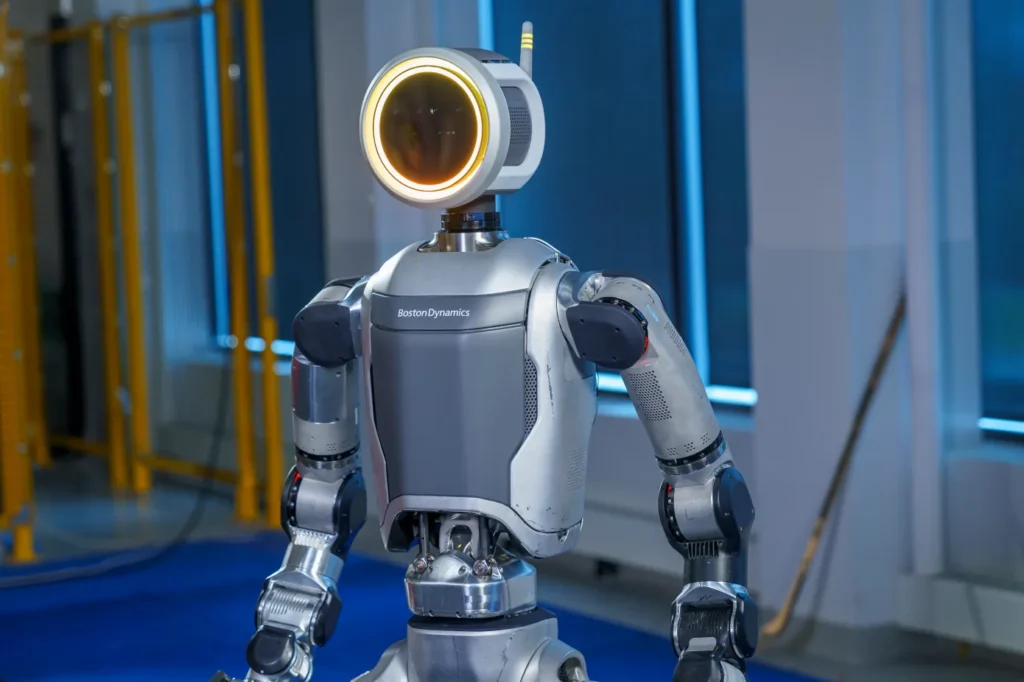Atlas lies still on mats. An electric motor whirs softly. Before, its movements were jerky. Now, they’re smoother. The camera shows its back. Its legs bend, then twist. Atlas stands up, facing away. Its head spins around. Then its torso follows. Finally, it walks away.
Boston Dynamics just retired the hydraulic version of its robot. Now, they’ve made Atlas go electric. The robot moves fast, but its steps are a bit jerky. Still, it’s smoother than many new humanoid robots. It reminds us of Spot, Atlas’ cousin. Spot is confident, like Atlas.
The New Atlas: A Kinder, Gentler Robot
The company has been dealing with people worrying about robots taking over for years. Now, they’re going for a friendlier design. It’s different from the old Atlas and other new robots like Figure 01 and Tesla Optimus.
The new Atlas looks more like other friendly robots, like Agility’s Digit and Apptronik’s Apollo. It’s got a softer, more cartoonish style. In the video, they call it the “All New Atlas.” Boston Dynamics is sticking with the name Atlas for now, even though they usually change the names when they make products for sale.
The CEO, Robert Playter, says they might change the name later when they’re ready to sell it in big numbers. But for now, they’re keeping it as Atlas.
The CEO’s words show that they’re still working on the robot. They plan to start testing it at Hyundai’s places next year. They’ve been getting stuff ready with Hyundai for a while. Making a successful robot isn’t just about having cool technology. You have to understand how people will use it and make sure it helps them be more productive.
“Next year, we’ll commence conducting trials in collaboration with Hyundai,” Playter announced. “We’ve got their stuff here already. We’ve been dedicating considerable time to this endeavor. To make this robot a success, we need more than just cool tech. We need to understand how people will use it and make sure it helps them get more done.”
Improving Industrial Robots
When you watch the short video of the “All New Atlas” robot, what stands out most is how it moves. The robot’s movements remind us that making a robot like a human isn’t necessary. A smart investor once told me that humans aren’t perfect machines, even after billions of years of evolution. So, if we’re making robots inspired by us, why not make them do things we can’t?
The person in charge of building the robot, Playter, says they used special, strong, and flexible parts in its joints. This gives the robot a wide range of motion, like a really strong athlete in a small body. They’ve used this ability in many parts of the robot.
Remember, Boston Dynamics, the company behind the robot, is famous for its cool videos. Sometimes, these videos show off the robot’s dance moves more than useful things it can do in factories. So, it’s hard to tell what’s really helpful and what’s just for fun.
Starting the robot from a lying position might seem like a show-off trick. But it’s actually useful. Just like they showed in another video, robots can fall down sometimes. Being able to stand up on their own is a big help for getting work done without needing humans to help them up.
The robot’s ability to turn quickly is also super useful. It reminds me of Agility’s Digit demos, where a robot goes to a shelf, turns around, and goes to a conveyor belt. Doing this job many times a day, faster turns can save a lot of time.
Playter expresses that it will possess capabilities beyond human abilities. “There will be highly beneficial employment opportunities for it.”
Making the robot turn in smaller spaces is also important. These robots are meant to fit into existing factories. Being able to turn tightly means they can work better without needing to change the factory layout.
So, by making robots that can move in special ways, we can improve how things work in factories. And that’s a big deal for making things faster and better!
Designing a Robot with Simple Hands and a Friendly Head
The hands aren’t new for the video. They were on a hydraulic model before. But they show the company doesn’t stick only to human designs. Instead of four fingers, they chose three for simplicity.
Playter remarks, “A hand encompasses a multitude of complexities.””When employing actuators, reliability is essential.” So, we made them with fewer fingers to keep things simple. We’re still working on improving them. We want them to grasp things gently and sense when they touch something.”
The head design caused some disagreement internally. It’s big and round, like a makeup mirror.
“We spent a lot of time worrying about it,” says Playter. “Everyone else’s robots look like humans. I wanted ours to be different. We aim for a welcoming and accessible appearance. It’s also a screen. There are sensors inside, but the shape is meant to be friendly. That’s important for how people interact with them in the future.”
Introducing Electric Atlas and Its Competitors
Lots of changes happened since the hydraulic Atlas was introduced ten years ago. Now, there are other robots like Electric Atlas from Figure, Apptronik, Tesla, and 1X.
People got really interested lately. Three big things happened that got everyone talking. First, Hyundai bought Boston Dynamics for almost a billion dollars.The recognition dawned: “Venturing into robotics could yield significant financial gains!”
Tesla has announced its intent to delve into the realm of robotics as well. That made people think, “Hey, maybe we’re on the right track.” And finally, AI is getting better at helping robots learn stuff. This makes it easier to make cool robots.
Even though Boston Dynamics started making human-like robots first, Playter says they finished building their new robot around Christmas 2023. Before that, they practiced a lot of hard stuff in a computer game.
Now, it seems like they’re ready to show off what the robot can do. Or at least, what they hope it can do in the future.
Making Robots Smarter
Elon Musk makes big promises. He talked about robots doing everything, like working in factories and cooking dinner. But for now, robots are taking small steps. They’re good at one task at a time, like moving things around.
Some companies talk about making robots that can do many things, but it’s tricky. They might use an app store idea, like your phone. But Boston Dynamics, the company behind Spot and Atlas, wants to do things differently.
They won’t make a platform for others to build on. Instead, they’ll focus on one thing at a time. They believe using AI is crucial. It’ll help robots learn different tasks.
Boston Dynamics is sharing Spot’s learning tricks with developers. This will help Atlas get smarter too.
Thinking Outside the Box
Robots that only do one thing are old-fashioned. Stretch is one of the last robots that only moves boxes and still works.”
What will the new Atlas robot do if not moving boxes at the Hyundai show floor? In a video from February, the robot with hydraulics was seen handling car struts, as Playter mentioned earlier.
“We possess considerable expertise in transporting bulky items while maintaining agility,” he remarks. “This makes us different. We can pick up heavy, complex objects. The strut in the video weighs about 25 pounds. We’ll show more videos later of Atlas manipulating real objects. We’re good at this, and I haven’t seen others doing it yet.”
Also Read: Devin AI Easy Way: Uses, Signup, Comparison and Future

